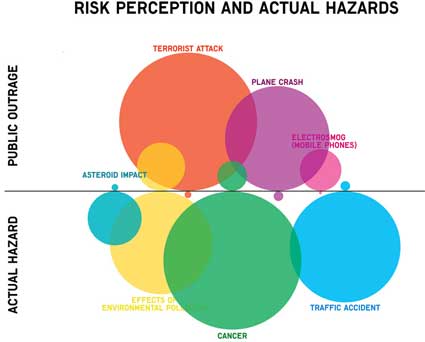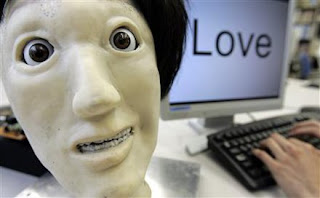Immediately after the events of September 11th news reports told us that gas-masks were selling out all over the place. (1)
You'd have thought people would have calmed down a bit by now, but apparently not..
I found a company called 'City Survive', (2) whose website offers a variety of products for eventualities such as a bird-flu outbreak or biological terror attack, and noticed immediately that almost all the products were apparently SOLD OUT! I laughed to myself. Is this real or just a marketing ploy to make vulnerable people feel even more worried?
The website even features a feed of the latest terrorism news, so you can keep up to date with when you might next need to use your shiny new gas mask...
How would owning a gas mask make someone feel? Is what is being sold here merely a sense
of reassurance or a real means of protection? Presumably these masks do what they claim, but as this diagram shows, the real risk of such an eventuality actually happening is small compared to the real risks that we seem less concerned about:

(3)
The way these items are sold is not necessarily ethical. It is in the best interest of the
companies marketing them have to create a sense of risk or hype up and intensify existing risk.
Are they doing an honest service that provides reassurance? Perhaps not when undeniably money is being made from people's fear.
Excerpt from 'City Survive' website:
"It is accepted by most that London is high on a list of potential terror targets.
The next attack could come in the form of more bombs bringing with them the potential for fire and the dangerous gases in smoke, or a more sophisticated attack involving chemical or biological agents.
City Survive's response to these threats is to bring you a range of compact, lightweight, easy to
carry gas masks and respirators, and our innovative City Survival Kit™, each designed to give you the best possible chance of surviving a specific terror driven scenario."
If something disasterous really did happen, having a TM on your survival kit isn't going to make it any more effective.
 The rather scary look of this mask, the 'Potomac Emergency Escape Mask' (pictured) is clearly unnecessary - it doesn't need to be yellow for a start, but perhaps if it was presented with a minimal, purely functional exterior it would offer less protection psychologically? The name is also over-dramatic. Up to now we've got along fine just calling them gas-masks.
The rather scary look of this mask, the 'Potomac Emergency Escape Mask' (pictured) is clearly unnecessary - it doesn't need to be yellow for a start, but perhaps if it was presented with a minimal, purely functional exterior it would offer less protection psychologically? The name is also over-dramatic. Up to now we've got along fine just calling them gas-masks.
When it comes to thinking about potential impending disaster the inevitable conclusion is that the existence of however many survival contraptions cannot prevent something actually happening. If owning one helps a person sleep better at night, I guess that's fine. But lets not get too worked up.
I found an interesting example of how the design world (obviously I'm making a distinction between commercial product design (the gas-masks) and non-commercial design/art) has reacted to risk culture.
Susanna Hertrich's work at the Design Interactions department, RCA, focuses on enhancing human perception of and reaction to risk. Her piece, Alertness Enhancing Device stimulates goosebumps and makes neck-hair stand up, making the user more alert and ready for real danger. (3)

Pretty cool.
1.http://www.guardian.co.uk/uk/2001/sep/26/afghanistan.september111
2.http://www.citysurvive.com/anti_terror_gas_masks.htm#survival_kit
3.http://www.we-make-money-not-art.com/archives/2008/02/alertness-enhancing-device.php











 Imagine an apple you can grow at a touch of a button, a dog that will obey every command, grass that changes colour to your mood and weather that is not just predictable, but controllable.
Imagine an apple you can grow at a touch of a button, a dog that will obey every command, grass that changes colour to your mood and weather that is not just predictable, but controllable.



















